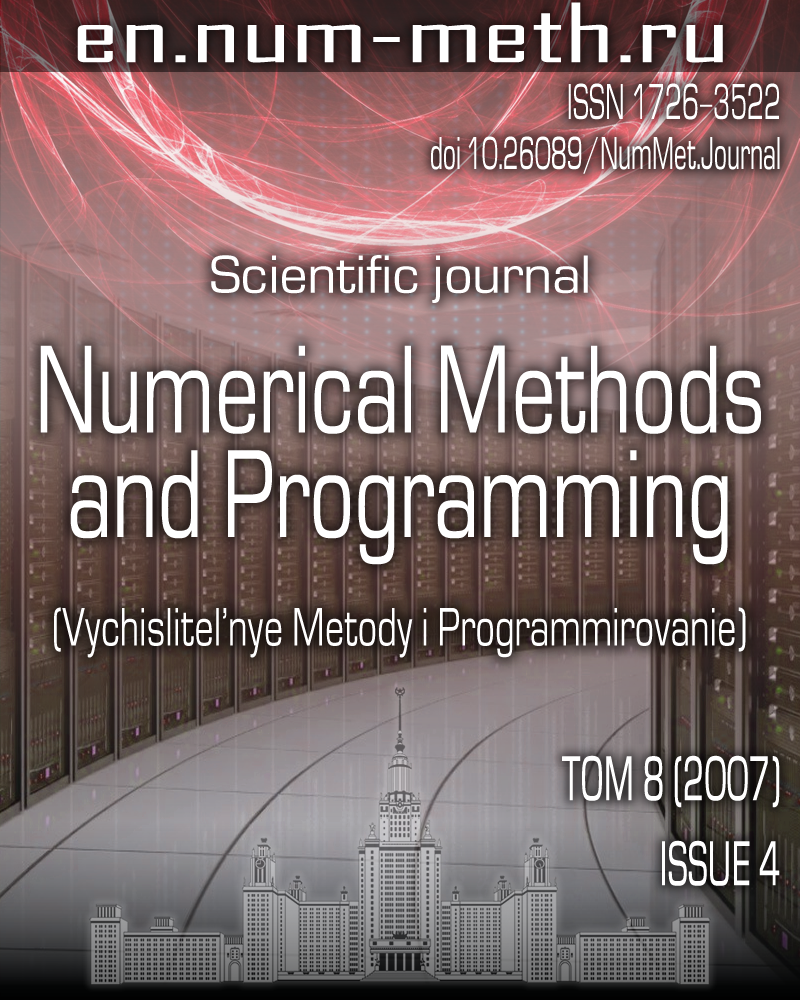A two-step method for the evaluation of free energy of formation for subnanometer cavities
Keywords:
Abstract
An original two-level scheme for the calculation of free energy of formation for cavities of various volume and shape in water by the method of thermodynamic integration. Statistical integrals are calculated with use of Monte Carlo sampling an ensemble of water molecules with periodic boundary conditions. An implementation of the proposed scheme is carried out in CAVE (CAVity free Energy) program. In order to determine the optimum parameters for modeling with the algorithm, some test computations for a sphere and for several organic molecules of small and average size were performed. The interaction between water molecules is described within the TIP4P water model. To test the CAVE program, a set of thermodynamic values of the TIP4P water model was computed. All the found values are in good agreement with the results known from the literature.
Published
Issue
Section
References
- Tomasi J., Persico M. Molecular interactions in solution: an overview of methods based on continuous distributions of the solvent // Chem. Rev. 1994. 94, N 7. 2027-2094.
- Gallicchio E., Kubo M.M., Levy R.M. Enthalpy-entropy and cavity decomposition of alkane hydration free energies: numerical results and implications for theories of hydrophobic solvation // J. Phys. Chem. B. 2000. 104, N 26. 6271-6285.
- http://www.gromacs.org/
- Brooks B.R., Bruccoleri R., Olafson B., States D., Swaninathan S., Karplus M. CHARMM: a program for macromolecular energy, minimization, and dynamics calculations // J. Comp. Chem. 1983. 4. 187-217 (http://www.charmm.org/).
- Floris F.M., Selmi M., Tani A., Tomasi J. Free energy and entropy for inserting cavities in water: comparison of Monte Carlo simulation and scaled particle theory result // J. Chem. Phys. 1997. 107, N 16. 6353-6365.
- Alexandrovsky V.V., Vasilevsky M.V., Leontyev I.V., Mazo M.A., Sulimov V.B. The binomial cell model of hydrophobic solvation // J. Phys. Chem. B. 2004. 108, N 40. 15830-15840.
- Kirkwood J.G. Theory of liquids. New York: Gordon and Breach, 1968.
- Chandler D. Interfaces and the driving force of hydrophobic assembly // Nature. 2005. 437, N 24. 640-647.
- Allen M.P., Tildesley D.J. Computer simulation of liquids. Oxford: Clarendon Press, 1989.
- Jorgensen W.L., Chandrasekhar J., Madura J.D., Impey R.W., Klein M.L. Comparison of simple potential functions for simulating liquid water // J. Chem. Phys. 1983. 79, N 2. 926-935.
- http://parallel.ru/cluster/
- http://www.msg.ameslab.gov/GAMESS/GAMESS.html
- http://www.gaussian.com/
- Bordner A.J., Cavasotto C.N., Abagyan R.A. Accurate transferable model for water, n-octanol and n-hexadecane salvation free energies // J. Phys. Chem. B. 2002. 106, N 42. 11009-11015.
- McCarrick M.A., Kollman P.A. Predicting relative binding affinities of non-peptide HIV protease inhibitors with free energy perturbation calculations // J. Comput. Aided Mol. Des. 1999. 13, N 2. 109-121.
- Halgren T.A. Merck molecular force field I: basis, form, scope, parameterization and performance of MMFF94 // J. of Comput. Chem. 1996. 17, N 5&6. 490-519.
- Григорьев Ф.В., Романов А.Н., Кондакова О.А., Лущекина С.В., Сулимов В.Б. // Алгоритм расстановки силовых параметров на атомах органических молекул и белков в рамках силового поля MMFF94 // Вычислительные методы и программирование. 2006. 7. 128-136.
- http://www.keenbase.ru
- Jarzynski C. Nonequilibrium equality for free energy differences // Phys. Rev. Lett. 1997. 78, N 14. 2690-2693.
- Oberhofer H., Dellago C., Geissler P.L. Biased sampling of nonequilibrium trajectories: can fast switching simulations outperform conventional free energy calculation methods? // J. Phys. Chem. B. 2005. 109, N 14. 6902-6915.
- Mu Y., Song X. Calculation of crystal-like interfacial free energies by nonequilibrium work measurements // J. Chem. Phys. 2006. 124, N 3. 0347121-0347125.


